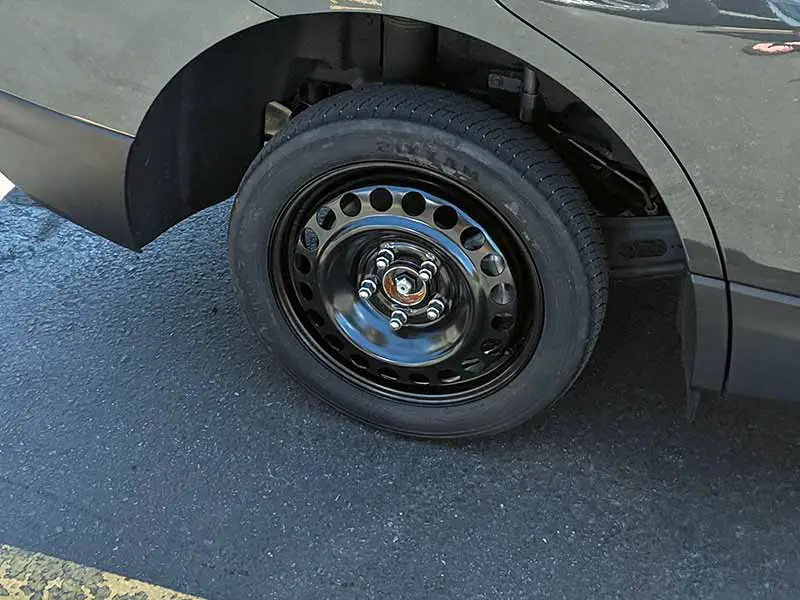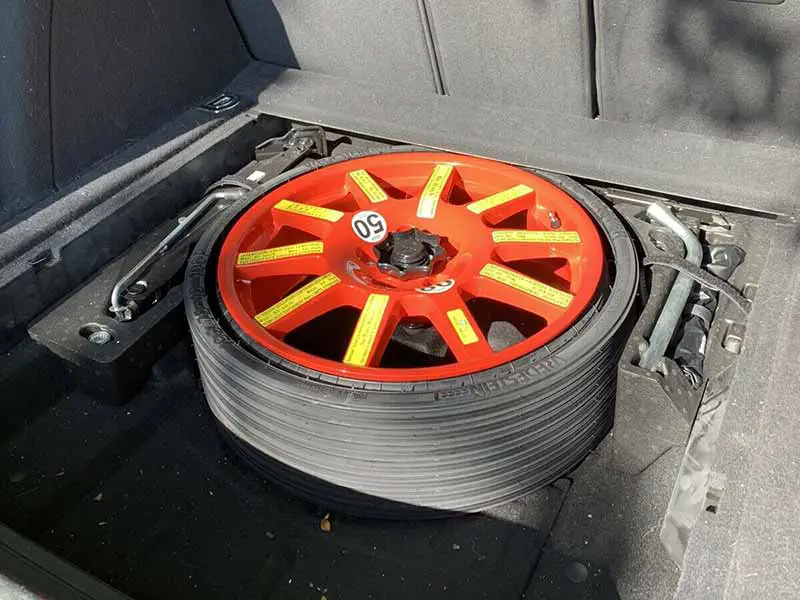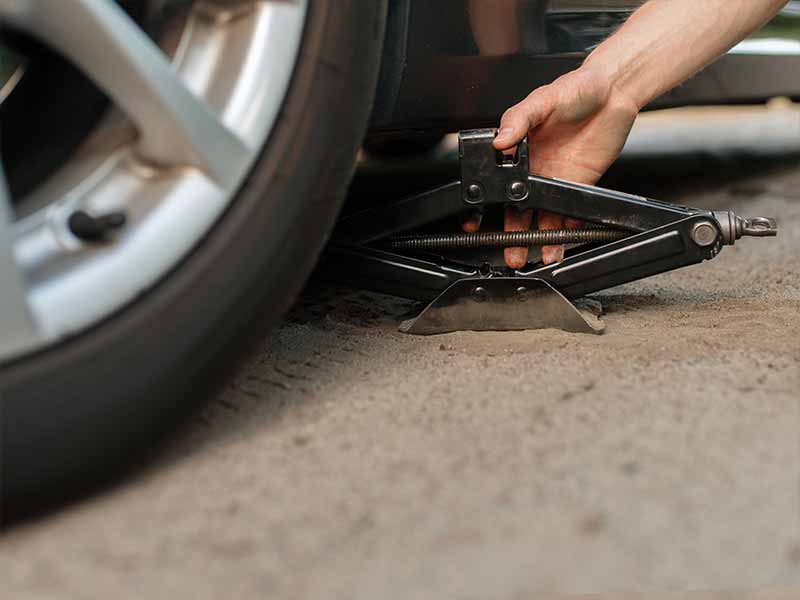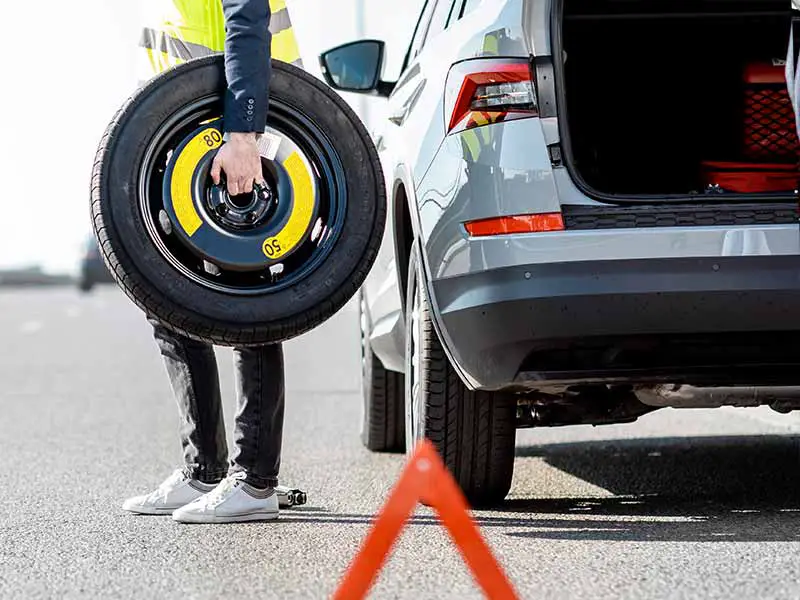Have you ever found yourself staring at the small, odd-looking spare tire in your trunk, wondering just how far and how fast it could actually take you? Well, grab a cup of coffee and settle in, because we’re about to dive into the fascinating world of donut spare tires!
Can I Drive 200 Miles On A Donut?
No, you should not drive 200 miles on a donut spare tire. Typically, it is recommended to limit your driving to 50-70 miles at no more than 50 mph when using a donut spare tire.
In this article, we’ll help you understand everything you need to know about donut spare tires: what they are, how they differ from regular tires, and their role in your vehicle’s safety. We’ll discuss the recommended usage limits for donut spare tires, both in terms of distance and speed, as well as the potential risks of pushing those limits. Plus, we’ll walk you through the steps to take if you ever find yourself needing to use one.
Let’s take a closer look.

Understanding Donut Spare Tires
Before we dive into the nitty-gritty, let’s get something straight: a donut spare tire isn’t like the regular tires on your car. In fact, it’s pretty different, and knowing those differences is super important.
The Difference Between Donut Spare Tires and Regular Tires
Donut spare tires, sometimes called space saver spare tires, are like the understudies in a play. They’re not meant to steal the show, but they’re there to step in when one of the regular actors (or tires, in this case) can’t perform.
- Size: You’ve probably noticed that a donut spare tire is smaller than your regular tire. That’s not a mistake. They’re designed to be compact so they can easily fit in your car without hogging too much space.
- Tread: The tread on a donut spare tire is different than on a regular tire. It’s not as deep or as aggressive, which means it’s not built for the same heavy-duty use.
- Construction: Donut spare tires are usually made to be lightweight. This means they aren’t as robust as your regular tires.
The Purpose of a Donut Spare Tire
The job of a donut spare tire is to get you out of a bind when you get a flat tire. It’s like a pinch-hitter in a baseball game. It’s not meant to be a permanent replacement. Instead, it’s designed to get you safely from the side of the road to a tire shop where you can get your flat tire fixed or replaced.
Remember, the donut spare tire is your car’s superhero, swooping in to save the day when you’re stuck with a flat. But, just like most superheroes, it works best when used sparingly and for short distances. It’s not designed for long trips or high speeds.
Donut Spare Tire Versus Full Size Spare Tire
It’s worth noting that some cars come with a full size spare tire. This is just like your regular tires and can be used just the same. But, these bigger spares take up more room and are heavier, which is why many cars opt for the smaller, lightweight donut spare.

Can I Drive 200 Miles on a Donut Spare Tire?
So, here’s the burning question: Can you actually drive 200 miles on a donut spare tire? In a nutshell, it’s not a good idea. Sure, it might seem like a superhero, but remember, even superheroes have limits!
The Recommended Distance for a Donut Spare Tire
Generally speaking, a donut spare tire isn’t built for long-distance travel. Think of it as a short-distance runner rather than a marathon champ.
Most manufacturers suggest that a donut spare tire should be used for no more than 50 to 70 miles. Of course, that’s just a general guideline. The exact safe distance can vary based on the specific type of donut spare tire you have, your vehicle, the driving conditions, and how loaded down your car is.
So, if you’re planning on driving 200 miles on a donut, it’s best to reconsider that plan. It’s better to make a pit stop at a nearby tire shop and get that donut replaced with a regular tire.
Why Long Distances are a No-Go on a Donut Spare Tire
You might be thinking, “Why can’t I just drive as far as I want on a donut spare tire?” Well, there are a few good reasons:
- Durability: Donut spare tires aren’t built as tough as regular tires. They have less tread and are made to be lighter. This means they wear out much faster than regular tires.
- Stability: Because of their smaller size, donut spare tires don’t have the same level of stability as a regular tire. This can affect your car’s handling and braking, making it more difficult to control, especially at higher speeds.
- Heat: Driving long distances, especially at high speeds, generates a lot of heat. Donut spare tires aren’t designed to handle this heat as well as regular tires, which could lead to tire failure.

The Effect of Speed on a Donut Spare Tire
We’ve talked about distance, now let’s switch gears and chat about speed. Just how fast can you drive on a donut spare tire? Well, it’s not about pushing limits, but rather, keeping things slow and steady.
The Recommended Speed for a Donut Spare Tire
Most manufacturers recommend that you don’t drive faster than 50 miles per hour when you’re using a donut spare tire. That’s not because they want to spoil your fun, but because it’s the safest speed to ensure you and your car stay out of harm’s way.
Why Speed Matters with a Donut Spare Tire
You might be wondering why speed is such a big deal with donut spare tires. Here’s the lowdown:
- Stability: As we’ve already discussed, donut spare tires are smaller and lighter than regular tires, which can affect your car’s stability. Going too fast can make it harder to control your car, especially around corners or when braking.
- Heat: Driving at high speeds generates more heat, and a donut spare tire isn’t designed to handle too much heat. Excessive heat can lead to tire failure, leaving you back at square one with a flat tire.
- Wear and Tear: High speed means more wear and tear. Remember, your donut spare tire isn’t as robust as your regular tire. The faster you drive, the quicker it wears out.
Driving on the Highway with a Donut Spare Tire
If you’re on the highway, you might feel the need for speed. But remember, safety comes first! It’s better to keep your speed down, stay in the right lane, and signal clearly when you’re using a donut spare tire. It’s also a good idea to use your hazard lights to let other drivers know that you’re moving slower than usual.

Risks of Overusing a Donut Spare Tire
We’ve talked about how donut spare tires aren’t built for speed or long distances. But what exactly happens if you ignore the warnings and decide to push your luck with a donut spare tire? Let’s get into that.
Dangers of Driving Too Long on a Donut Spare Tire
Driving on a donut spare tire for too long isn’t just bad for the tire, it could also be harmful to your car and, most importantly, dangerous for you. Here are some of the risks:
- Heat Buildup: Overusing a donut spare tire, especially at high speeds, can cause it to heat up significantly. This can potentially lead to a tire blowout, which is definitely not something you want to experience, especially when driving at speed.
- Increased Wear on Other Tires: Because a donut spare tire is smaller than a regular tire, your other tires have to work harder to keep the car moving. This can lead to increased wear on your remaining good tires.
- Potential Damage to Your Vehicle: Prolonged use of a donut spare tire can put extra strain on your vehicle’s differential, which is the part of your car that splits the engine’s torque two ways, allowing your wheels to spin at different speeds. Over time, this can cause damage that could require costly repairs.
Replacing Your Donut Spare Tire
Knowing all the risks, it’s pretty clear why you should replace your donut spare tire as soon as possible. Take your car to a tire shop and have the donut spare tire replaced with a regular tire. If your regular tire was just flat and is otherwise in good shape, it can often be repaired.

What To Do If You Get a Flat Tire
Now that you know all about donut spare tires, what should you do if you get a flat tire? Don’t panic, we’ve got you covered. Here’s a simple step-by-step guide.
Step-By-Step Guide to Changing a Flat Tire
- Find a Safe Place to Stop: If you suspect you have a flat tire, don’t slam on the brakes or abruptly swerve to the side of the road. Slow down, signal, and carefully move to a safe and flat area away from traffic. If possible, try to stop under a streetlight or in a well-lit area if it’s dark.
- Turn on Your Hazard Lights: Make sure other drivers can see you by turning on your hazard lights.
- Apply the Parking Brake: This will help prevent your car from moving while you’re changing the tire.
- Remove the Spare Tire and Tools: Get your donut spare tire, jack, and lug wrench out of your car.
- Loosen the Lug Nuts: Use the lug wrench to loosen the lug nuts on the flat tire (don’t remove them completely yet).
- Raise Your Car with the Jack: Position the jack in the right spot (your car’s manual can tell you where) and raise your car off the ground.
- Remove the Lug Nuts and Flat Tire: Now you can fully remove the lug nuts and then the flat tire.
- Put on the Donut Spare Tire: Put your donut spare tire on the car and hand-tighten the lug nuts as much as you can.
- Lower the Car: Lower your car back down to the ground using the jack, but don’t put all the weight on the donut spare tire just yet.
- Tighten the Lug Nuts: Fully tighten the lug nuts using your lug wrench.
- Check Tire Pressure: If possible, check the pressure in the donut spare tire to ensure it’s safe to drive on.
Remember, this is a basic guide. Your car’s manual may have specific instructions you should follow.
Next Stop: Tire Shop
After you’ve successfully installed your donut spare tire, your next destination should be a tire shop. It’s crucial to replace the donut spare tire with a regular tire as soon as possible. The professionals at the tire shop can help you decide whether your flat tire can be repaired or if it needs to be replaced.
Full Size Spare Tire Versus Donut Spare Tire
As we’ve mentioned before, some cars come with a full size spare tire. If you have one, you can drive on it just like a regular tire, but remember to still get your flat tire checked out. If you’re using a donut spare tire, remember it’s just a temporary fix.
Resources
Below are some links you may find helpful when learning about tires
- Limping home 250 miles on a temporary spare tire – The Drive
- Five things you should know about a spare tire – Autoblog
Final Thoughts
We’ve taken quite a journey, haven’t we? We’ve explored the mysterious world of donut spare tires, delving into their purpose, limitations, and the correct way to use them. Now it’s time to recap the key takeaways from our expedition:
- Donut spare tires are temporary solutions: They are designed to get you out of a tricky situation when you have a flat tire. They’re not meant for long trips or high speeds, and they certainly aren’t designed to replace your regular tire for an extended period of time.
- Limit your distance and speed: Generally, you should only drive 50-70 miles on a donut spare tire, and you shouldn’t exceed 50 mph. If you’re thinking about that 200-mile journey on your donut spare, it’s time to rethink that plan!
- Excessive use can lead to problems: Driving too far or too fast on a donut spare tire can lead to increased wear on your other tires, potential damage to your vehicle, and even a tire blowout. It’s always safer to get your regular tire fixed or replaced at a tire shop as soon as possible.
- Changing a flat tire is doable: With the right tools and instructions, you can replace a flat tire with a donut spare tire. Just remember, it’s a temporary fix.
- Safety first: Always prioritize safety. Drive slower, don’t go too far, and get that regular tire back on as soon as you can.
Remember, while donut spare tires might seem like the unsung heroes in the world of automobiles, they’re simply stepping in to help you get to a safer place where you can rectify the issue. They’re the understudies, not the stars of the show. So, treat them kindly, respect their limitations, and keep your regular tire in the spotlight!
Good luck and happy motoring.





